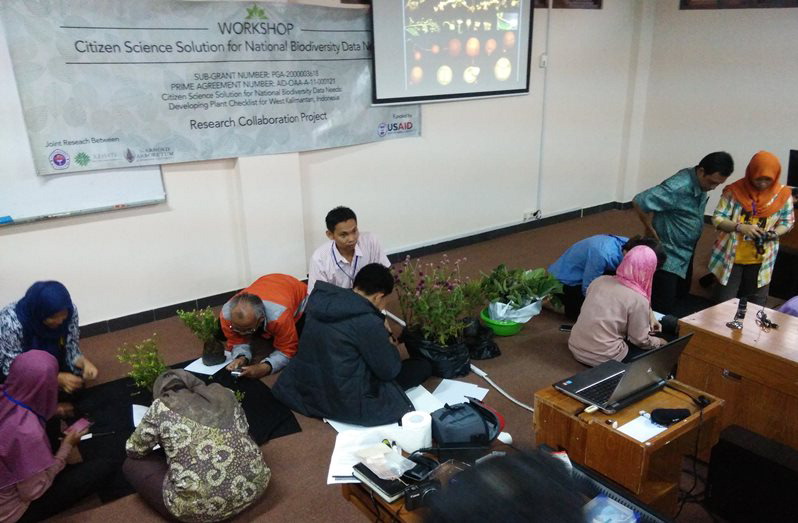After completing their two-day initial training course in Pontianak in late January 2014, 12 parataxonomists from different educational and employment backgrounds took part in a series of multi-day field workshops over the following eight months. Equipped with tablets pre-installed with a digital library, digital cameras, and netbooks for image storage and curation, the participants took part in a 15-day expedition to an under-explored area of West Kalimantan, where they put their skills to work, photographing and identifying plants. The data collected were uploaded and integrated into the project platform, and photographs of some plants were matched by technicians at the national herbarium. Although most of the plants encountered were common, as was expected, the teams collected 1,693 plant samples plus associated metadata, as well as more than 20,000 images (50 Gigabytes). The U.S. partner developed metadata structure for the platform. A total of 907 unique species were found, 786 of which were identified as common.
The portal’s inventory of specimens provided some learning and reference material to be used by specialists, students, or the general public. The system has automatically incorporated new data into a dynamically generated checklist for identification that is accessible and downloadable in various formats.
Three of the parataxonomists later became trainers themselves as part of a three-day workshop for biology undergraduates at Tanjung Pura University in August 2014. The PEER team also held a week-long workshop in Jakarta in October 2014 for parataxonomists who already had extensive field survey experience throughout Indonesia, as well as a three-day biodiversity training course in March 2015 and other workshops and seminars to share their results and the portal.
The project team has presented the new system to the Municipal Government in Jakarta, which manages the Thousand Islands National Park, as the team plans to deploy a similar system for conducting a biodiversity inventory in Pulau Seribu. They also introduced the use of the platform for Biodiversity Warriors Group from the NGO KEHATI and presented their results to the Ministry of Research Technology and Higher Education. Finally, they have also presented the system to the Ministry of Research Technology and Higher Education as an example relevant to the Ministry’s current Science and Technology Information System (SIIN) project.
In terms of human capacity building, this research led to the creation of a new special course on web semantics and the addition of a new research theme to the doctoral degree program in information technology at Gunadarma University. It has resulted in conference proceedings publications (one international, one Indonesian), three Master’s theses, and two bachelor’s theses.
PublicationsOvan Sunarto Pulu, Fitri Nurjannah, and Kartika Dwintaputri S. 2016. Manual Book-Aplikasi Flora-indonesia.id.
Kartika Dwintaputri Siregar, I Made Wiryana, Teguh Triono, and Campbell O. Webb. 2015.
Flora-Indonesia.id, A Citizen Science Approach for Biodiversity Informatics Portal.
Proceedings of the 5th Uzbekistan-Indonesia International Joint Conference on Globalization, Economic Development, and Nation Character Building.
Fitri Nurjannah, Kartika Dwintaputri S, and Panchit Longpradit. 2013.
Social Network for Citizen Scientist to Support the Development of Wise Management and Policy in Biodiversity.
Proceedings of the 3rd Uzbekistan-Indonesia International Joint Conference on Economic Development and Nation Character Building to Meet the Global Economic Challenges.




